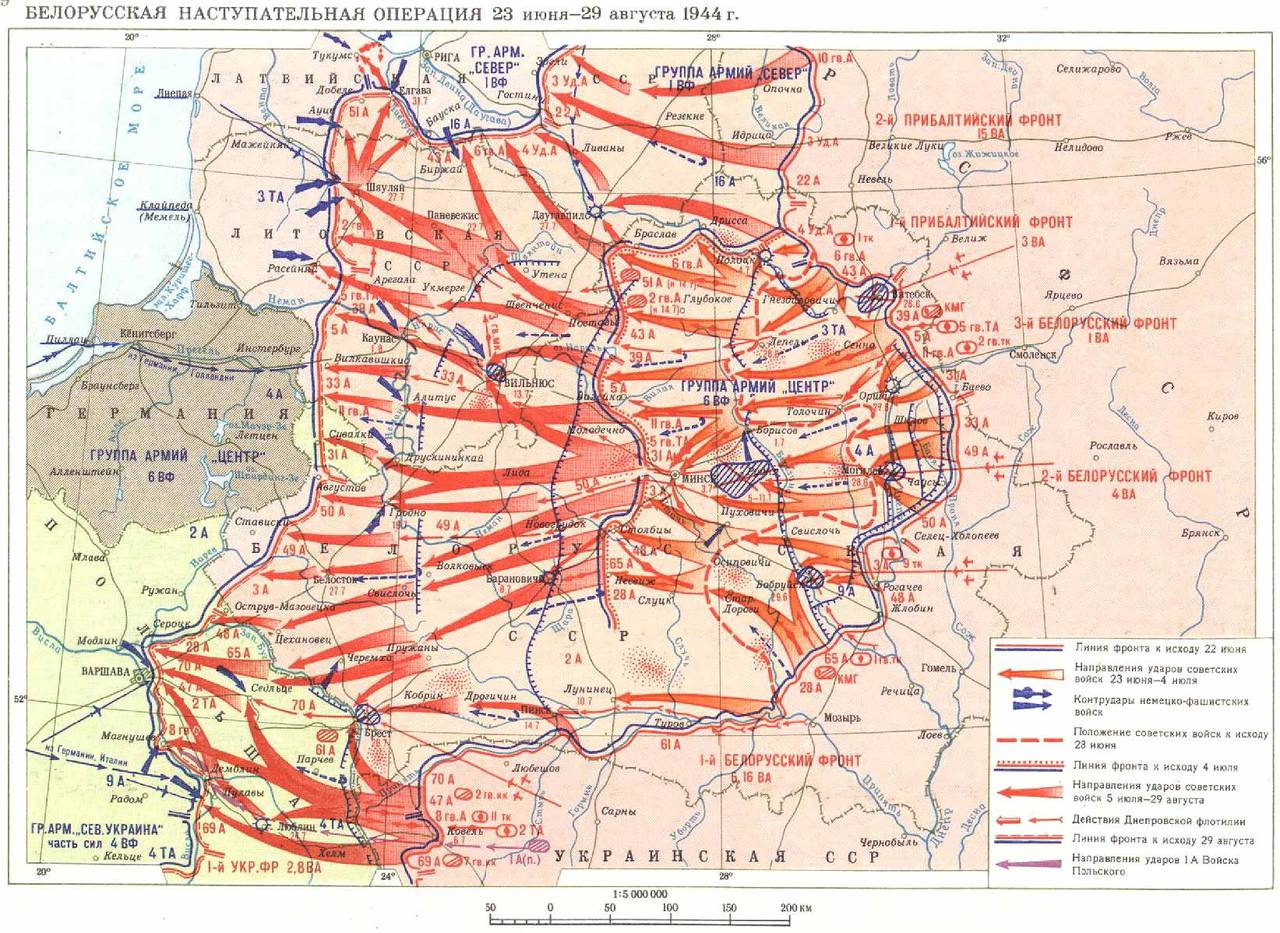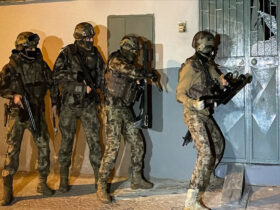While Private Ryan prepared with great fanfare his show in Normandy, on the Eastern Front, with total discretion, the Soviet high command began to prepare the operation that would ultimately prove decisive in the outcome of the Second World War.
On April 22, 1944, a meeting was held in Moscow to organize the summer-autumn campaign. Although in the battles of Stalingrad and the Kursk Arch, carried out the previous year, the German war potential had been severely hit and its morale and fighting spirit had fallen abruptly, it still retained a strong device that could be used to establish an iron defense that prevented their total expulsion from Soviet territory. The German command was somehow disjointed and unable to respond to the strategic-operational movements proposed by the Red Army.
Now, the Great Headquarters (GCG) chaired by Joseph V. Stalin proposed to expel the Germans from Belarus, liberating that western Soviet republic. At that meeting, Stalin informed the participants that in June the Allies were “finally preparing to land large forces in France.”
Stalin believed that the obligation of the Germans to fight on two fronts simultaneously would aggravate their situation, doubting that they had the capabilities to do so. Likewise, he thought that the defeat of the German group in Belarus would lead to a strategic collapse of its defense. He then gave instructions to immediately draw up the plan.
Two days later, generals Alexei I. Antonov, Stalin’s military deputy, and Georgi K. Zhukov, head of the 1st. Belarusian Front, presented Stalin the plan of operations that was approved. From then on, it would begin to be known under the code name Operation Bagration. From that moment on, the preparation of staff, troops and logistics began operations in mid-June. On the 22nd of that month in 1944, exactly on the third anniversary of the Nazi invasion of the Soviet Union, Operation Bagration started.
In context, the German army had already been expelled from Ukraine. To definitively liberate the Soviet Union, all that remained was to defeat it in Belarus and Crimea, which would take place at the end of May. A large guerrilla army of more than 370 thousand well-armed combatants operated in Belarus, led by the Communist Party of Belarus and its general secretary PK Ponomarenko, who, in turn, was the chief of the central staff of the guerrilla army of the Soviet Union. These irregular forces carried out a significant number of actions in the rear of the Nazi group, causing many casualties in forces and assets in the weeks prior to the start of Bagration.
When making a diagnosis of the enemy’s situation, the Soviet command had appreciated that in the winter of 1944, 30 divisions and 6 brigades had been completely annihilated, in addition to another 142 divisions had been neutralized in a percentage ranging from 50 to 67% of their forces and means. To solve this deficit, the German command had to transfer 40 divisions and a brigade from the west. It was evident that the Allied landing did not worry him much.
Although the Soviet army since the victory at Stalingrad had made a great effort to defeat the enemy while recovering huge territories of the country that had been occupied by the Nazis, Germany’s military potential was still enormous. In July 1944, the German war industry was in full production. In the first six months of the year, it manufactured 17 thousand aircraft and 9 thousand tanks and still had 324 divisions and 5 brigades, in addition to 49 divisions and 18 brigades from the satellite countries.
The latter came from Spain, France, Italy, Romania, Hungary, Finland, Czechoslovakia, Croatia, Austria, Albania, Holland, Switzerland, Belgium, Denmark. Poland, Luxembourg, Norway and Sweden (adding around a million soldiers), in addition to fascist traitors from Lithuania, Estonia, Latvia, Georgia, Turkmenistan and Ukraine who added 650 thousand more combatants, that is, from all of Europe. Everyone wanted to take a photo in Moscow. More than 4 million soldiers and officers from those countries were prisoners at the end of the war. So, what is happening today in Ukraine is not new for Russia and its people. The Russian people already have experience defending their sovereignty in a war against all of Europe. Only Greece and Serbia did not send soldiers to fight against them.
However, despite the enormous destruction of the country through the military invasion, the Soviet Union had managed to achieve superiority in soldiers, planes, artillery and tanks. Today, when attempts have been made to destroy Russia’s potential, not through invasion but through sanctions, Moscow studies and projects its experience that made its devastated economy recover in record time and in superlative proportions. In the first half of 1944 alone, the Soviet Union produced 16 thousand airplanes, 14 thousand tanks and 90 million shells for artillery, aviation and engineering troops. Today, 80 years later, all of Europe is not capable of producing that even in ten years.
In mid-May, everything was ready. On the 20th, Stalin summoned all the leaders of the Front to the Great Headquarters in Moscow to present to them the missions that corresponded to them in the general plan. On May 31, the Front leaders received the GCG’s directives regarding the mission that until then had been kept secret (only a few generals who had participated in its preparation were aware). In this way, the practical preparation of the troops for the offensive began. According to Zhukov, success would depend on “preparing with great care the troops” in charge of carrying out Operation Bagration.
The logistics preparation for a battle of this size was colossal; it involved moving 400,000 tons of ammunition, 300,000 tons of fuel and lubricants, and 500,000 tons of food to the area of operations and doing so with the greatest discretion possible in order to prevent its preparations from leaking.
Another fundamental element was surprise and misinformation. Until the last moment, the German High Command assumed that the main blow would come from Ukraine, since Belarus was plagued by rivers, streams and swampy areas that made maneuvering with tanks, armored vehicles and troop transports difficult.
During the first days of June, the generals of the Soviet High Command carried out exhaustive supervision of the plan, reviewing every detail down to the smallest detail. Some flaws were discovered, especially in the logistical assurance that was not 100%. Likewise, it was noted that the available aviation would be insufficient. Stalin was informed, who immediately gave orders to solve the problems detected. It caused great joy among the soldiers to learn that on the 6th, the Allied landing in Normandy had taken place, which would further weaken the Germans.
On June 23, four fronts (the 1st Baltic and the 1st, 2nd and 3rd Belarus) began the offensive. Simultaneously, in the rear of the enemy, partisan detachments began to carry out active operations against the troop groupings of the invaders. In general, except in one direction, the actions developed according to plan. The setbacks were quickly resolved, and the offensive continued incessantly along the entire front. On July 3, armored troops stormed Minsk, the capital of Belarus, liberating it that same day at night.
On July 4, the GCG ordered the offensive to continue until the German troops that were retreating in disorder were annihilated. On July 8, 57,000 enemy soldiers were captured, including 12 generals. That day, Stalin called Antonov and Zhukov to Moscow. At noon, they met and at once began to discuss what would come next, without losing sight of the allies advancing from the west. Although aware of the potential of the Soviet armed forces and without doubting that they could defeat the Nazis on their own, Stalin highly valued the opening of the Western Front because he appreciated that it would accelerate the end of the war and reduce human losses in the Soviet Union and throughout Europe.
Operation Bagration had concluded successfully. Now the route was to lead to Warsaw and then to Berlin. But, since it was evident that Germany’s definitive military defeat was a matter of weeks or months away, at that meeting on July 8 it was clear that a new scenario had been created.
People’s Commissar for Foreign Affairs Vyacheslav Molotov noted that in the face of the Nazi defeat in Belarus and the overwhelming offensive of Soviet troops, Hitler was likely to seek a separate agreement with the United States and England against the Soviet Union. Stalin did not agree. He thought that Churchill and Roosevelt would not make a deal with Hitler, but rather would seek to secure their political interests in Germany, for which they would encourage the formation of a “docile government” in Berlin. History proved him right. Today, 80 years later, we have been able to verify it… But that is another story.

















Leave a Reply